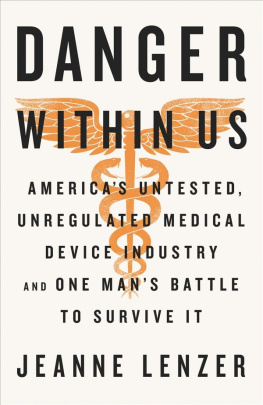Hachette Book Group supports the right to free expression and the value of copyright. The purpose of copyright is to encourage writers and artists to produce the creative works that enrich our culture.
The scanning, uploading, and distribution of this book without permission is a theft of the authors intellectual property. If you would like permission to use material from the book (other than for review purposes), please contact permissions@hbgusa.com. Thank you for your support of the authors rights.
Little, Brown and Company is a division of Hachette Book Group, Inc. The Little, Brown name and logo are trademarks of Hachette Book Group, Inc.
The publisher is not responsible for websites (or their content) that are not owned by the publisher.
The Hachette Speakers Bureau provides a wide range of authors for speaking events. To find out more, go to hachettespeakersbureau.com or call (866) 376-6591.
WHEN I WAS STUDYING to be a physician associate (PA) at Duke University, I was taught to diagnose and treat common and not-so-common illnesses. As a practicing PA, I wrote prescriptions, performed minor surgical procedures, and made referrals to specialists. I thought that if I stayed on top of new developments in medicine, and was caring and conscientious enough, I could help people. I wouldnt harm patients. Certainly I wouldnt kill them.
I was wrong.
For years, I worked in rural emergency rooms, serving as the sole on-site medical provider for patients with everything from sprained ankles to heart attacks and major trauma.
When I saw patients with chest pain, I routinely ordered several drugs, including one called lidocaine, given to prevent or stop extra heartbeats known as premature ventricular contractions (PVCs). Although PVCs can occur occasionally in healthy individuals and arent dangerous in themselves, they tend to occur more frequently in heart attack patients, and they have the potential to touch off deadly heart rhythms.
Lidocaine was widely seen as a lifesaving drug. Professional organizations such as the American College of Emergency Physicians and the American Heart Association (AHA) had issued guidelines recommending lidocaine for routine use in patients with acute chest pain. And like doctors across the nation, I had faith in the drug, not just because it was recommended but because Id seen it save the life of a man too young to die.
Mr. R. was in his early forties when he was wheeled into the small rural ER where I was working as the medical provider along with two nurses. One of the nurses recognized him as a local firefighter. He had crushing chest pain and was sweating profusely. I saw the look of terror in his eyes and knew he was wondering, Am I going to die? Within minutes I had ordered oxygen, aspirin, nitroglycerin, and morphine for Mr. R. and was just about to add lidocaine when the alarm on his heart monitor suddenly emitted its high-pitched squeal. I looked up to see the fluorescent green tracing revealing a run of PVCs. I ordered the lidocaine, which the nurse injected into an intravenous line.
The first few minutes after a heart attack are always tense. If one of those PVCs touched off the deadly rhythm known as ventricular fibrillation, Mr. R. was likely to be dead within minutes. The nurse completed the injection. The PVCs persisted. As the alarm continued to screech, I felt beads of sweat collect on my upper lip. Finally the lidocaine took hold. The electrical storm was over. Mr. R.s heart was beating normally. The alarm fell silent, and I exhaled.
The ability of lidocaine to magically erase these abnormal beats made me secure in the belief that Id helped a patient cheat death. Over the years, I repeated this process for patients with chest pain many times. It felt good to save lives.
Until I found out I wasnt saving lives at all.
In the early 1990s, more than a decade after the AHA had recommended lidocaine for chest-pain patients, studies with disturbing results began to emerge. In 1993, one author wrote in the Journal of Emergency Medicine that although the drug could reduce PVCs, overall mortality may be increased. A study sponsored by the National Institutes of Health called the Cardiac Arrhythmia Suppression Trial (CAST) found that, although oral drugs related to lidocaine, such as flecainide and propafenone, could suppress PVCs, if they did occur despite the medication, the PVCs were more likely to trigger deadly rhythms. Researchers found that the patients whod been medicated were actually 3.6 times more likely to die. Thus lidocaine and related drugs could fix the PVCs but kill more patients than they saved in the process. To put it in the vernacular: the operation was a success, but the patient died.
When I learned about the lidocaine study, I was devastated. I was also fascinated. Could it be true that we were killing patients when we were eyewitnesses to so many cures? And if so, if we were really killing patients, why didnt we see the carnage wed caused?
I began to search for answers. I stayed up late at night reading about clinical trials and statistics. I attended as many medical conferences as the dollars in my pocket allowed. The more I learned, the more obsessed I became. I wanted to know how and why it was possible for patients and doctors alike to become involved in this massive folie deux, a dance in which everyone was convinced that the march of medical progress was saving lives even when it wasnt. How had the best and the brightest doctors, including the guideline writers at the American Heart Association, been fooled? And if we could be fooled by this class of drugs, how many other mirages were we chasing? How many more patients were we harming?
What I learned eventually led me to a very unusual doctor who was able to explain how and why medical illusions like the belief in lidocaine as a lifesaver arise: Dr. Jerome R. Hoffman, then a professor of medicine and emergency medicine at UCLA. Hoffman helped me understand how easy it is for healthcare professionals to make deadly errors despite their best intentions and advanced training, and Ill share a number of his insights later in this book. These revelations also led me to leave my career in medicine more than a decade ago to become an investigative medical journalist.
Since that time, and especially while writing this book, Ive been stunned to learn how frequently complications produced by a medical treatment are mistaken for symptoms of the underlying conditiona phenomenon I refer to as cure as cause. The failure to consider a treatment or cure as the cause of a bad outcome means that when a patient dies following a heart attack, we assume that the death was due to the heart attack and not to the medicine we gave. Examples can be found in virtually every specialty, from emergency medicine to psychiatry, cancer care, infectious diseases, and more. Mistaking the ill effects of a treatment as symptoms of the condition being treated is an illusion that is both natural and understandableand its an illusion that the healthcare industry repeatedly exploits to reap enormous profits.
But I was in for yet another shock when I learned the untold story of medical devices and how they, too, can cause the very symptoms they are intended to cure. I began to delve into the rise of the medical device industry and its disturbing role in the healthcare business. Although many concerned citizens have grown distrustful of the pharmaceuticals industry, thanks to the high-profile exposs of dangerous drugs such as Vioxx and Avandia, the same skepticism is largely lacking about implantable devicesfrom simple devices such as the surgical mesh used for hernias and urinary incontinence to an array of more complex devices such as deep-brain stimulators; spine implants with biologically active bone stimulators; Wi-Fi-enabled pacemakers and defibrillators; breast implants; brain-fluid shunts; intrauterine devices; filters that catch blood clots on their way to the heart; lens implants for cataracts; cadaver bone used for dental surgery; artificial heart valves; gastric bands; artificial hips, knees, and elbows; hormonal implants; cochlear implants; radium seeds; stents to hold coronary, carotid, and renal arteries open; stents that release drugs; and more. The public and doctors often perceive these devices as advanced products of cutting-edge technology that are inert and so, unlike drugs, dont have serious side effects.








